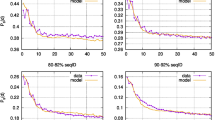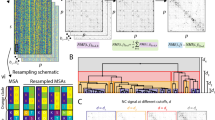Abstract
Arising from: I. K. Jordan et al. Nature 433, 633–638 (2005); Jordan et al. reply
Understanding how proteins evolve is important for determining the molecular basis of adaptation, for inferring phylogenies and for engineering novel proteins. It has been suggested that some amino acids were incorporated into the genetic code more recently than others1 and, after comparing pairs of closely related genomes, Jordan et al.2 report that 'recent' amino acids are becoming more common. They argue that this process has been going on since the genetic code first evolved to encompass all 20 amino acids. Here we provide evidence that the patterns observed conform with standard, nearly neutral theoretical expectations3 and require no new explanation. This reinforces the need for caution in the interpretation of results derived from closely related taxa.
This is a preview of subscription content, access via your institution
Access options
Subscribe to this journal
Receive 51 print issues and online access
$199.00 per year
only $3.90 per issue
Buy this article
- Purchase on Springer Link
- Instant access to full article PDF
Prices may be subject to local taxes which are calculated during checkout


Similar content being viewed by others
References
Trifonov, E. N. J. Biomol. Struct. Dynam. 22, 1–11 (2004).
Jordan, I. K. et al. Nature 433, 633–638 (2005).
McDonald, J. H. Mol. Biol. Evol. 23, 240–244 (2006).
Rocha, E. P. et al. J. Theor. Biol. 239, 226–235 (2006).
Sharp, P. M. et al. Phil. Trans. R. Soc. Lond. B 356, 867–876 (2001).
Ho, S. Y., Phillips, M. J., Cooper, A. & Drummond, A. J. Mol. Biol. Evol. 22, 1561–1568 (2005).
Penny, D. Nature 436, 183–184 (2005).
Brooks, D. J., Fresco, J. R., Lesk, A. M. & Singh, M. Mol. Biol. Evol. 19, 1645–1655 (2002).
Akashi, H. & Gojobori, T. Proc. Natl Acad. Sci. USA 99, 3695–3700 (2002).
Keightley, P. D., Lercher, M. J. & Eyre-Walker, A. PLoS Biol. 3, 282–288 (2005).
Author information
Authors and Affiliations
Corresponding author
Rights and permissions
About this article
Cite this article
Hurst, L., Feil, E. & Rocha, E. Causes of trends in amino-acid gain and loss. Nature 442, E11–E12 (2006). https://doi.org/10.1038/nature05137
Published:
Issue Date:
DOI: https://doi.org/10.1038/nature05137
This article is cited by
-
Estimating the Influence of Physicochemical and Biochemical Property Indexes on Selection for Amino Acids Usage in Eukaryotic Cells
Journal of Molecular Evolution (2021)
-
Allosteric disulphide bonds as reversible mechano-sensitive switches that control protein functions in the vasculature
Biophysical Reviews (2019)
-
Genome wide exploration of the origin and evolution of amino acids
BMC Evolutionary Biology (2010)
-
The Universal Trend of Amino Acid Gain–Loss is Caused by CpG Hypermutability
Journal of Molecular Evolution (2008)
-
Enzyme-Driven Speciation: Crystallizing Archaea via Lipid Capture
Journal of Molecular Evolution (2007)
Comments
By submitting a comment you agree to abide by our Terms and Community Guidelines. If you find something abusive or that does not comply with our terms or guidelines please flag it as inappropriate.



